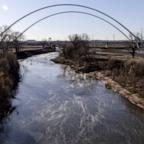Roswell: Alien Spacecraft or Top Secret Spy Project?
After 60 years, facts, legend and myth still collide.
July 7, 2007 — -- In July 1947, something remarkable happened outside Roswell, N.M., something that literally put the town on the map. The debris is long gone, but the reverberations have never stopped.
Was it an alien spaceship that crashed, killing its otherworldly occupants? Or just a weather balloon? It depends on whom you ask or what you read, and whether you believe them.
Enough people, however, believe the UFO story to warrant two simultaneous festivals this weekend as Roswell, population 53,000, celebrates the 60th anniversary of an event that etched Roswell into the memories of the public.
Ten years ago, for the 50th anniversary of the Roswell incident, an ABC News poll asked people what they thought of UFOs: "Are they something real, or just people's imagination?"
Forty-eight percent of those polled said they were real, with 36 percent saying they were imagined. From those who said they were real, 16 percent said they were likely to be alien spacecraft.
First, the facts. The one and only thing that absolutely everybody — believers, skeptics, military and the U.S. government — agrees on is that in early July 1947, something fell out of the sky and crashed on a ranch near Roswell, leaving scattered debris.
Ranch foreman Mac Brazel told Roswell's sheriff, George Wilcox, about the debris. Wilcox then called nearby Roswell Army Air Field, home of the 509th Bomb Group.
An intelligence officer, Maj. Jesse Marcel, headed out with Brazel to the debris field, where Marcel collected much of the material, described as shiny wreckage, including pieces of rubber, super-resistant tinfoil, wooden sticks, and what appeared to be I-beams of metallic-looking material.
En route to the Roswell base, Marcel stopped at home to show some of the debris to his wife and 11-year-old son, Jesse Marcel Jr.
"My dad woke me and my mother up. ... He knew this was so unusual that he wanted us to see it," Marcel Jr. said.
Marcel Jr., who recently returned from a 13-month stint as a flight surgeon in Iraq, told ABC News that seeing some of the debris had a lasting impression on him.
"There were these I-beams about 12 to 18 inches long, and the most unusual part of that was the symbols or writing on the inner surface. I thought, at first, it was like Egyptian hieroglyphics, but when I looked closer, it seemed more like geometric symbols of some kind — it was very strange," he said.
After Marcel Sr. brought the material to the Roswell Army Air Field, Col. William Blanchard ordered the base press officer, Lt. Walter Haut, to issue a press release indicating that the military had recovered a crashed flying saucer that was being shipped to the Eighth Air Force in Fort Worth, Texas.
Reporters clamored for more details about the amazing discovery. But just as quickly, as the flying saucer story emerged, it was deflated. A follow-up press release said the debris was, in fact, from a weather balloon.
"When my dad got home," Marcel Jr. recalled, "he sat my mother and myself down and told us never to talk about this again, this was a nonevent, it didn't happen. He was part of the cover-up. He was a good soldier following orders."
But the legend of Roswell didn't truly take shape until 30 years later.
In 1978, former nuclear physicist Stanton T. Friedman met the retired Marcel, who convinced him that he and other eyewitnesses from 1947 were willing to talk about what was really found on that ranch, something that Marcel referred to as "not of this Earth."




